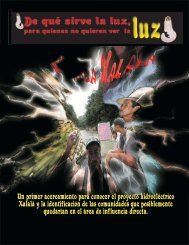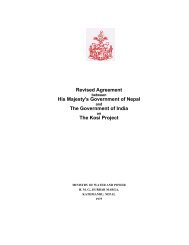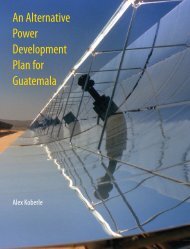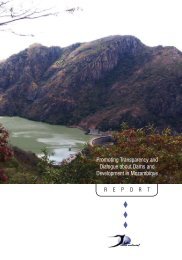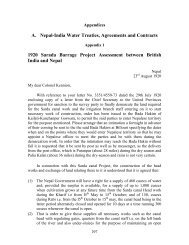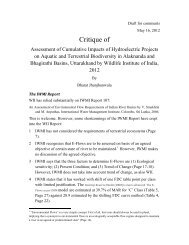Proposed Power Development Plan (PDP) 2012 - Palang Thai
Proposed Power Development Plan (PDP) 2012 - Palang Thai
Proposed Power Development Plan (PDP) 2012 - Palang Thai
- No tags were found...
You also want an ePaper? Increase the reach of your titles
YUMPU automatically turns print PDFs into web optimized ePapers that Google loves.
<strong>Proposed</strong> <strong>Power</strong> <strong>Development</strong> <strong>Plan</strong> (<strong>PDP</strong>) <strong>2012</strong>and a Framework for Improving Accountability and Performance of <strong>Power</strong> Sector <strong>Plan</strong>ningCost to consumersFrom public policy economics perspectives, decisions in the best interest of the country or the public should bebased on economic costs (total costs to the society), not financial cost of a company or state-owned utility. For thepower sector, economic costs of electricity include externality costs (such as environmental and health impacts ofpower production) as well as externality benefits (such as job creation). Coal electricity may appear “cheap” butwhen its full costs of health and environmental impacts are taken into account, it is very expensive. Likewise,hydroelectric dams appear “cheap” only because their full costs of loss of biodiversity and ecological impacts arenot internalized.Even if we do not consider externality costs, the way cost comparison of different generation options is typicallydone in the <strong>PDP</strong> process only compares generation costs and is therefore biased towards large-scale, centralizedgeneration and against other cleaner options. EE/DSM savings happen at the end-users and therefore requires nodistribution or transmission infrastructure. Distributed generation such as VSPPs generates electricity close to theload and thus only requires distribution system to move electricity to end-users (incurring no costs of transmissionand less losses along the way). Large-scale (centralized) generation incurs the full costs of delivery (transmissionand distribution). The <strong>PDP</strong> <strong>2012</strong> relies more on energy efficiency, renewable energy, cogeneration, and plant-lifeextension or repowering. Although renewable energy and cogeneration have higher generation costs, this issomewhat mitigated by lower transmission costs (see Table 24).<strong>Plan</strong>t TypeCost of electricity (not including externalities) (Baht/kWh)Generation Transmission 1 Distribution 2 TotalEE & DSM 1.00 3 - - 1.00Lignite-Mae Moh 1.50 4 0.37 0.44 2.31Hydro - Imports 2.11 5 0.37 0.44 2.92Imported coal - EGAT/IPP 2.12 6 0.37 0.44 2.93Gas - EGAT/IPP 2.29 6 0.37 0.44 3.10SPP - gas/coal/RE 2.60 7 0.198 0.44 3.23Nuclear 2.79 9 0.37 0.44 3.60RE VSPP 3.75 10 - 0.44 4.19Diesel 4.12 11 0.37 0.44 4.93Fuel oil - EGAT/IPP 4.12 6 0.37 0.44 4.93Table 24: Cost of delivered electricity (not including externalities) in Baht/kWh.Notes: (1) Based on assumption that 12.4% of total electricity cost comes from transmission system.(2) Based on assumption that 14.5% of total electricity cost comes from distribution system.(3) The number represents an average of the estimate cost of actual energy savings from EE/DSM (0.5-1.5B/kWh) (Source: (du Pont 2005)).(4) Author’s estimation.(5) Average of power purchase costs from hydroelectric projects in Lao PDR (Source: (EPPO 2007),Slide41).(6) These were the assumed costs in <strong>PDP</strong> 2007 and were based on assumed constant oil prices and thuslikely to be on the low side. (Source: (EPPO 2007), Slide 63).(7) Purchase price according to SPP regulations.(8) SPPs are distributed generation connected at distribution level. Some SPPs are however large enoughthat they require transmission system to wheel power to the load. Here, 50% of electricity from SPPsis assumed to move through transmission and hence the transmission cost is half that of centralizedgeneration.36







